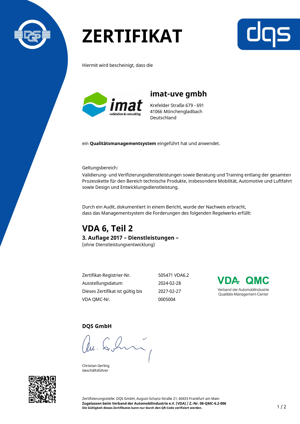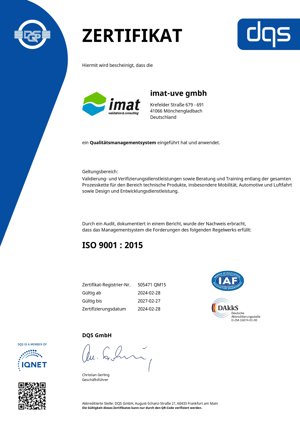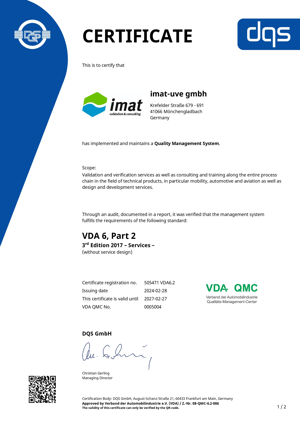Textile testing
Textiles under the magnifying glass
Imagine that your automotive textiles not only offer maximum comfort, but also withstand the toughest conditions. As an automotive supplier or manufacturer, you know how crucial the quality and reliability of automotive textiles are to the success of your products. Defects such as thread pulls, insufficient abrasion resistance or color abrasion can lead to safety risks, customer dissatisfaction and unexpected costs.
At imat, we understand the challenges you face every day. Our extensive laboratory testing in the automotive industry ensures that your materials meet the highest standards. From the durability of roll goods to comprehensive tests for abrasion resistance, fire testing or emissions and much more. - we test your textiles down to the smallest detail. You can rely on our more than 30 years of experience and state-of-the-art testing technologies to ensure that your textiles are optimally adapted to the requirements of the automotive industry.
Our test portfolio includes chemical-analytical and mechanical-physical tests and covers all relevant aspects of textile testing. Our laboratories are accredited according to DIN EN ISO/IEC 17025, TISAX® and many more and are approved by well-known automotive manufacturers (OEM) , which gives you additional security and confidence in the quality of our tests. Let us work together to ensure that your automotive textiles deliver the quality your customers expect.
Physical / mechanical tests
- Abrasion resistance (e.g. Martindale test, Taber abrasion test, etc.) Evaluation of resistance to wear and tear.
- Stick-slip
- Soiling behavior and cleaning
- Tensile strength: Measurement of the maximum load that a textile material can withstand before it tears.
- Elongation / stretch behavior: Flexibility of a material
- Tear resistance: Determination of the material's ability to withstand a tearing force.
- Pilling resistance (e.g. Martindale pilling test, etc.): Evaluation of the tendency to form small fiber nodules on the surface of the material.
- Mace snag: Evaluation of the tendency of textiles to form threads or damage through snagging and rubbing.
- Dimensional stability before and after cold/heat storage
- Further tests
Emissions & odor
- VOC emissions: Measurement of volatile organic compounds (VOCs) released by textiles to ensure that no harmful substances are emitted.
- Fogging: gravimetric and reflectrometric
- Formaldehyde: determination of formaldehyde release.
- Odor tests: Evaluation of the odor development of textiles under various conditions to ensure that no unpleasant odors are produced.
- Emission chamber method: Evaluation of emissions of volatile organic compounds (VOCs) and other volatile substances released from vehicle parts.
- Microchamber: Evaluation of emissions from very small samples under controlled conditions.
- Bag method: Determination of emissions of volatile substances from vehicle materials, in particular for the evaluation of VOCs and aldehydes.
- Further tests
Color fastness
- Color fastness to light
- Color fastness to rubbing
- Color fastness to water/ water stains/ sea water
- Color fastness to perspiration
- Color fastness to dry cleaning
- Color fastness to burning (potting fastness)
- Further tests
Burning behavior / flammability
- Determination of the burning behavior / flammablity of interior materials (horizontal test method)
- Burning behavior of interior materials after climate storage or heat storage
- Horizontal burning test according to Taiwan VSTD 19-1 (191) - § 19-1.5
- Further tests
Resistance to exposure light
- Color fastness tests / color fastness and aging against artificial light at high temperatures
- Exposure test (hot light ageing) / UV radiation
- Xenon test
- Kalahari or Arizona test
- Florida test
- Further information can be found here
Chemical surface tests
- Media resistance (before and after climate/heat storage, environmental simulation)
- Resistance to chemical stains
- Resistance to cleaning agents
- Resistance to solvents
- Resistance to hydrolysis
- Resistance to oil and fuels
- Further tests

Typical textiles in the automotive industry
These materials undergo extensive testing to ensure that they meet the stringent requirements of the automotive industry and guarantee the safety, comfort and satisfaction of your customers.
- Yarn and fibers: Basic textiles that are used to manufacture various vehicle textiles and whose quality is crucial for the end products.
- Seat cover fabrics: Materials for the upholstery and covers of car seats, which must meet high standards of comfort and durability.
- Carpets and floor coverings: Hard-wearing textiles that protect the vehicle floor while providing comfort.
- Headliner fabrics: Lightweight but robust materials used in the roof area of the interior.
- Door panel fabrics: High-quality textiles that give the inside of the vehicle doors an aesthetic and functional finish.
- Trunk linings: Robust fabrics that are used in the trunk and are resistant to abrasion and soiling.
- Sun visors: Materials used in sun visors to protect the interior from direct sunlight.
- Instrument panel trim: Special textiles used in the dashboard trim area that offer a pleasant feel and durability.
- Belts and seat belts: High-strength textiles that are used in seat belts and must meet strict safety standards.
- Insulation materials: Textiles that contribute to sound and heat insulation in the vehicle interior.
- Business Development Team
- Other requests







DO YOU HAVE ANY QUESTIONS? GET IN TOUCH WITH US!
Accreditations/ Certificates
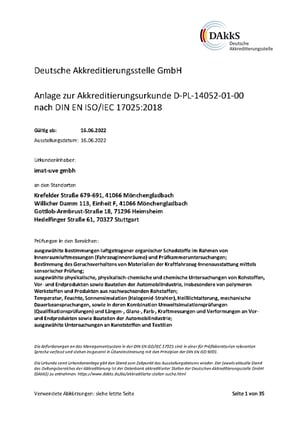
CERTIFICATE DIN EN ISO/ IEC 17025
DOWNLOADS


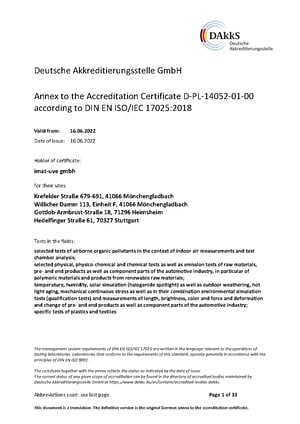
CERTIFICATE DIN EN ISO/ IEC 17025


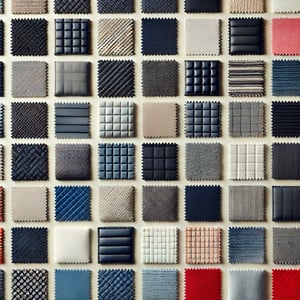
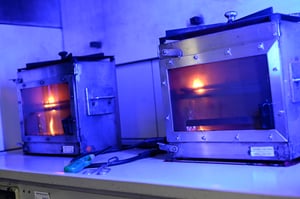
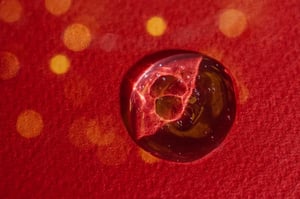







_550px.jpg?width=300&name=Probenhalter_Rendering_151112_1_bueckech-(1)_550px.jpg)
